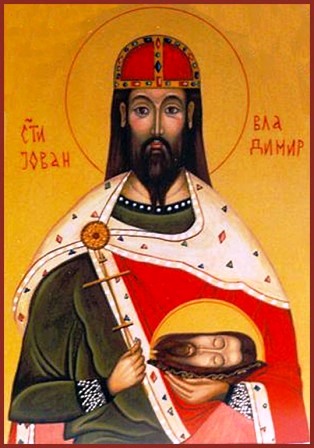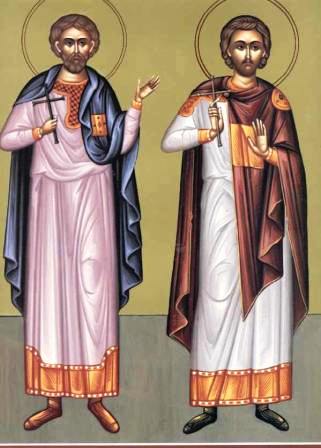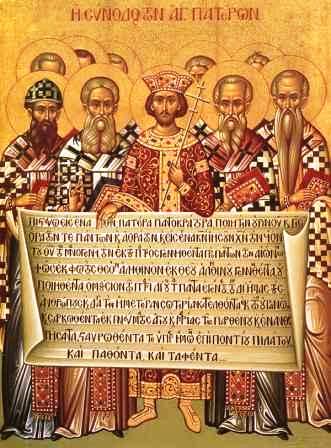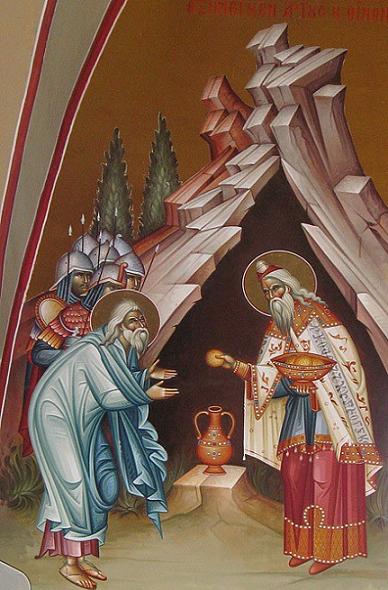|
|
The Holy Martyr John Vladimir, King of Serbia He came of a princely family from Zahumlje. His grandfather was named Hvalimir and his father Petrislav. He was a wise ruler; merciful, meek, chaste and courageous. He was fervent in prayer and a devoted builder and benefactor of churches. But he had major battles to fight, both inside and outside his realm; internally with heretics and Bogomils, and externally with invaders, with King Samuel and the Emperor Basil. Samuel captured him by guile and threw him into prison. While he was in prison, an angel of God appeared to him and foretold that he would soon be released from prison, but that he would die a martyr"s death. Getting to know Vladimir better, Samuel became attached to him and gave him his daughter Kosara in marriage. When Samuel died, his son Radomir became king, but his twin brother Radislav killed him and then summoned Vladimir on some pretext and beheaded him as well, in 1015. The relics of this holy martyr-king are preserved uncorrupt in his monastery near Elbasan, and numerous wonders have been worked over them through the ages and to this day. In 1925, a church was built to this royal martyr near the monastery of St Naum, which famous monastery he founded. He came of a princely family from Zahumlje. His grandfather was named Hvalimir and his father Petrislav. He was a wise ruler; merciful, meek, chaste and courageous. He was fervent in prayer and a devoted builder and benefactor of churches. But he had major battles to fight, both inside and outside his realm; internally with heretics and Bogomils, and externally with invaders, with King Samuel and the Emperor Basil. Samuel captured him by guile and threw him into prison. While he was in prison, an angel of God appeared to him and foretold that he would soon be released from prison, but that he would die a martyr"s death. Getting to know Vladimir better, Samuel became attached to him and gave him his daughter Kosara in marriage. When Samuel died, his son Radomir became king, but his twin brother Radislav killed him and then summoned Vladimir on some pretext and beheaded him as well, in 1015. The relics of this holy martyr-king are preserved uncorrupt in his monastery near Elbasan, and numerous wonders have been worked over them through the ages and to this day. In 1925, a church was built to this royal martyr near the monastery of St Naum, which famous monastery he founded.The Holy Martyr Basiliscus A kinsman of St Theodore the Tyro, he was martyred together with Eutropius and Cleonimus (March 3rd). When these two were crucified and gave up the ghost, Basiliscus was taken back to prison. A change of governors occurring at this time, Basiliscus remained a long time confined in prison. He besought God with tears that He would not deprive him of a martyr's death for His sake. After he had prayed at length, the Lord Jesus appeared to him and promised to fulfill his desire, sending him to his village to say farewell to his mother and brothers. Thereupon the new governor, Agrippa, arrived and sent to have Basiliscus brought from the village immediately. On the way to the city of Amasea, the Lord worked great wonders through His martyr, bringing many of the people to faith in Christ. Agrippa ordered the martyr to offer sacrifice to Apollyon. "'Apollyon" means "Destroyer"', said Basiliscus, and, with fervent prayer, he knocked the idol to dust and burned the temple with fire from heaven. The terrified Agrippa attributed this all to magic, and ordered that Basiliscus be beheaded with the sword. Agrippa immediately became insane and, in his madness, went to the place of execution, found a little of the martyr's blood in the dust and smeared it on himself under his belt, being restored to health by it. Having come to his senses, he was baptised. Later, a certain Marinus, a citizen of Comana (the place of Basiliscus's execution) built a church over the martyr's relics, and many of the sick found healing there. A kinsman of St Theodore the Tyro, he was martyred together with Eutropius and Cleonimus (March 3rd). When these two were crucified and gave up the ghost, Basiliscus was taken back to prison. A change of governors occurring at this time, Basiliscus remained a long time confined in prison. He besought God with tears that He would not deprive him of a martyr's death for His sake. After he had prayed at length, the Lord Jesus appeared to him and promised to fulfill his desire, sending him to his village to say farewell to his mother and brothers. Thereupon the new governor, Agrippa, arrived and sent to have Basiliscus brought from the village immediately. On the way to the city of Amasea, the Lord worked great wonders through His martyr, bringing many of the people to faith in Christ. Agrippa ordered the martyr to offer sacrifice to Apollyon. "'Apollyon" means "Destroyer"', said Basiliscus, and, with fervent prayer, he knocked the idol to dust and burned the temple with fire from heaven. The terrified Agrippa attributed this all to magic, and ordered that Basiliscus be beheaded with the sword. Agrippa immediately became insane and, in his madness, went to the place of execution, found a little of the martyr's blood in the dust and smeared it on himself under his belt, being restored to health by it. Having come to his senses, he was baptised. Later, a certain Marinus, a citizen of Comana (the place of Basiliscus's execution) built a church over the martyr's relics, and many of the sick found healing there.The Second Ecumenical Council This Council was held in Constantinople in 381, in the time of the Emperor Theodosius the Great. Its purpose was to confirm the teaching of the Orthodox Church about the Holy Spirit. Macedonius, Bishop of Constantinople (d. 362), had taught wrongly that the Holy Spirit is God"s creature and not a divine Person, equal to the Persons of the Father and the Son and one in being with them. Macedonius was condemned by this Council and the Nicene Creed was amplified with teaching on the Holy Spirit. This Council was held in Constantinople in 381, in the time of the Emperor Theodosius the Great. Its purpose was to confirm the teaching of the Orthodox Church about the Holy Spirit. Macedonius, Bishop of Constantinople (d. 362), had taught wrongly that the Holy Spirit is God"s creature and not a divine Person, equal to the Persons of the Father and the Son and one in being with them. Macedonius was condemned by this Council and the Nicene Creed was amplified with teaching on the Holy Spirit.Holy and Righteous Melchisedek, King of Salem He was a contemporary of our forefather Abraham. According to the Apostle Paul, he was, as king and priest, a type of the Lord Jesus (Heb. 7). He was a contemporary of our forefather Abraham. According to the Apostle Paul, he was, as king and priest, a type of the Lord Jesus (Heb. 7).New Monk-martyrs Paul (1818)Martyr Markella
Martyr Codratus
Martyr Sophia the Healer
|